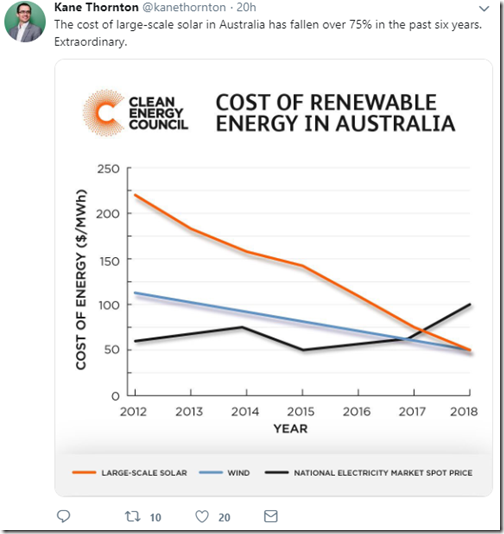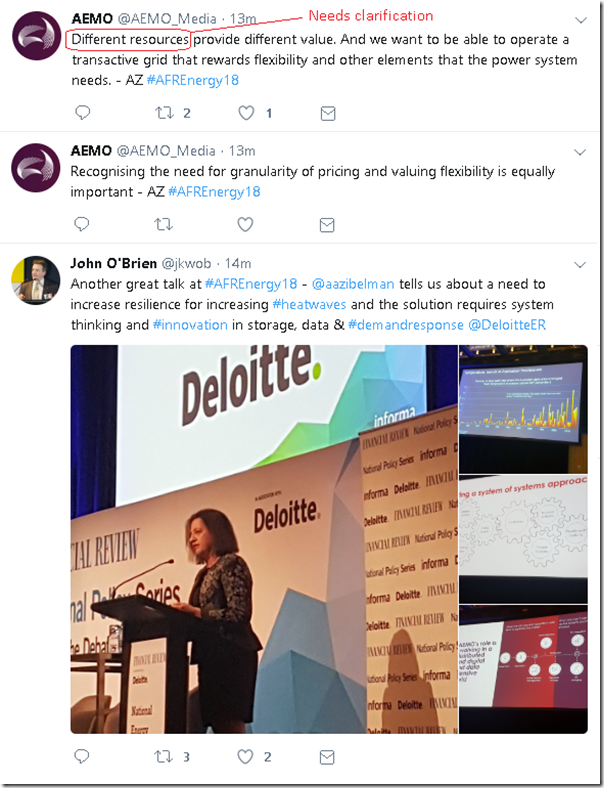It’s been apparent to me for some time that this trip-wire is growing in significance as a Villain that’s working to ensure that this energy transition is taking a much rockier path than should otherwise be the case.
Over the weekend, I noticed another round of this sort of announcements:
I fully recognize that this (decline in cost) has been a remarkable achievement – however (and this is important) I am increasingly concerned that many see this as the destination and not an interim milestone on a longer, and more significant journey.
… or to state another way – we’re well past the time when our focus should have collectively shifted from cost, to a focus on value.
(A) Obsessive focus on COST is increasingly dangerous
Before a proportion of our readers suffer from apoplexy, let me reiterate that the reduction in cost is a remarkable achievement (notwithstanding some broader confusion about when measures like LCOE are applicable, and when they are not really appropriate as a measure – an example of Villain no4).
However, it is clear to me that an ongoing obsessive focus on cost (as the destination) is going to end up with the industry in a mess.
As the technologies for solar PV and wind harvesting grow and mature (with storage technology also on the journey as well), it’s necessary that the market focus of those involved in those technologies also needs to mature.
We’ve been increasingly involved with new entrants in helping them focus on the market when ”the rubber’s hit the road” on their projects. This has entailed plenty of conversations – as a result of which it seems to me that there are too many still running around with the mindset of engineers* obsessed with their latest gadget whilst really paying only lip service to what the customer actually values (and in some – quite scary – cases, seeing the CER as the customer).
* Full Disclosure – I’m an engineer, so well understand the temptation of the bright shiny new thing.
(B) Instead, we need to increasingly focus on VALUE
On the upside, we have seen some broader recognition from others in the energy sector that acknowledges the high importance of value. For instance, a few months earlier (at the AFR Energy Summit) a few notes from AEMO CEO Audrey Zibelman’s speech caught my eye, as the notes did talk more about the value side of the equation.
Unfortunately (which is what’s causing the concern) is this is still relatively rare.
(C) Focus on COST is easy – Understanding VALUE (seems) much more difficult
Let’s see if I can explain the reasons for my growing concern – as evidence would suggest that not everyone is currently seeing the same Villain:
(C1) A focus on COST is easier (though less-and-less helpful)
I can understand some of the reasons why this focus on cost has evolved.
Reason #1) A number of years ago, the cost of production from wind and solar generation meant it was not in the ballpark of what was required without significant external support in some form. A focus on cost was necessary in order to achieve the cost reductions necessary for it to be more than a token contribution. That’s quite clearly no longer the case today.
Reason #2) I can also understand that many supporting these new technologies feel compelled to get drawn into the shouting match with the “rabid right” of the Emotion-o-meter (though in my view this is probably doing more harm than good, and will increasingly be the case in future). It’s increasingly become a huge distraction to the maturation process that is essential to keep this energy transition process on the rails.
Reason #3) At an individual level, and especially for the engineering types who are heavily involved in new technologies, a focus on COST certainly seems to be easier – because:
3a) The sense is that COST has to do with all the things that seem to be within the entrepreneurs control (“within the fence”, so to speak), whereas
3b) The sense is also that VALUE pertains to all those “more difficult” things (“outside the fence”) like the market, connection points in the grid, and connections standards – and delivering power at the time, and the place, the customer needs it.
(C2) A brief analytical exercise
I’d suggest a simple arithmetical exercise for our readers – simply nominate a period of time (say the coming week) and keep a tally in two columns:
Column #1 – the number of articles, tweets, retweets, comments and so on that you notice about how the COST of supply from renewables has fallen significantly.
Column #2 – the number of articles, tweets, retweets, comments and so on that you notice talking more about VALUE.
My sense is that Column #1 will have a far longer list than Column #2.
(C3) An insular focus leads to conspiracy theories
We are seeing it increasingly in conversations we’ve been having (and what we’ve seen written elsewhere):
(a) My Marginal Loss Factors have changed significantly, which was not in my business plan → it must be a conspiracy! Alas, no, just physics and Villain no4
(b) I’m being constrained down much more than was in my business plan → it must be a conspiracy! Alas, no, though it will be a big surprise in northern Queensland for some, it would seem
(c) My average spot revenue is suffering, and I am seeing more negative prices → who can I blame? Just the “solar correlation penalty” and “wind correlation penalty” at work.
(d) I’m needing to actively manage my solar and/or wind farm projects, even to the extent of establishing a 24 x 7 operations room → Nobody told me, and the cost is not factored into our business case;
(e) Those phone calls from other new entrants along the lines of “you can’t expect us to incur the cost of establishing these operations – the rebidding rules are there for the other big, bad generators!” in response to this earlier article that raised some questions. The rules are there for a reason, and apply to all for very valid reasons.
the list goes on…
For as long as new entrants are led to believe that COST is the number 1 performance metric, we’ll continue seeing these sorts of rude awakenings. It won’t end well, and could be a systemic risk for the energy transition as a whole.
(C4) Respected clean energy focal points are a key
What triggered me to write this post today was the current round of social media coverage prompted by the Clean Energy Council on the weekend (tweet copied above – at the time of posting today it had 5 replies, 91 retweets and 147 likes).
I understand the popularity – but I also understand that respected industry focal points (like the CEC, the Smart Energy Council, and so on) can play a significant role in re-starting the progression of the broader energy sector up the maturity curve.
Lower unit COST of delivery is an interim milestone on the journey to delivering customer VALUE
In doing so we’d go a long way to avoiding the bumpy future ride that this energy transition is headed towards.





Leave a comment